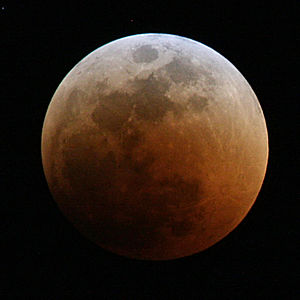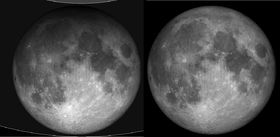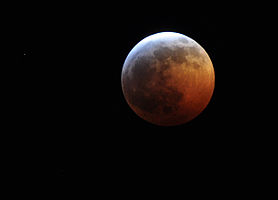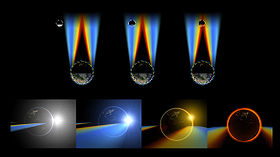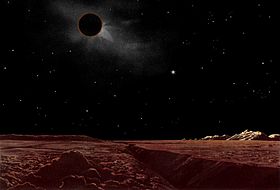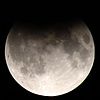- Lunar eclipse
-
For other uses, see Lunar eclipse (disambiguation).Not to be confused with Solar eclipse.
A lunar eclipse occurs when the Moon passes behind the Earth so that the Earth blocks the Sun's rays from striking the Moon. This can occur only when the Sun, Earth, and Moon are aligned exactly, or very closely so, with the Earth in the middle. Hence, a lunar eclipse can only occur the night of a full moon. The type and length of an eclipse depend upon the Moon's location relative to its orbital nodes. The most recent total lunar eclipse occurred on June 15, 2011; it was a central eclipse, visible over Europe and South America after sunset, over Africa and most of Asia, and Australia before sunrise. It lasted 100 minutes. The previous total lunar eclipse occurred on December 21, 2010, at 08:17 UTC.[1]
Unlike a solar eclipse, which can only be viewed from a certain relatively small area of the world, a lunar eclipse may be viewed from anywhere on the night side of the Earth. A lunar eclipse lasts for a few hours, whereas a total solar eclipse lasts for only a few minutes at any given place, due to the smaller size of the moon's shadow.
Contents
Types of lunar eclipse
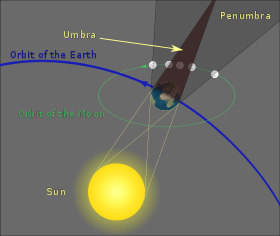 Schematic diagram of the shadow cast by the Earth. Within the central umbra shadow, the Moon is totally shielded from direct illumination by the Sun. In contrast, within the penumbra shadow, only a portion of sunlight is blocked.
Schematic diagram of the shadow cast by the Earth. Within the central umbra shadow, the Moon is totally shielded from direct illumination by the Sun. In contrast, within the penumbra shadow, only a portion of sunlight is blocked.
The shadow of the Earth can be divided into two distinctive parts: the umbra and penumbra. Within the umbra, there is no direct solar radiation. However, as a result of the Sun’s large angular size, solar illumination is only partially blocked in the outer portion of the Earth’s shadow, which is given the name penumbra. A penumbral eclipse occurs when the Moon passes through the Earth’s penumbra. The penumbra causes a subtle darkening of the Moon's surface. A special type of penumbral eclipse is a total penumbral eclipse, during which the Moon lies exclusively within the Earth’s penumbra. Total penumbral eclipses are rare, and when these occur, that portion of the Moon which is closest to the umbra can appear somewhat darker than the rest of the Moon.
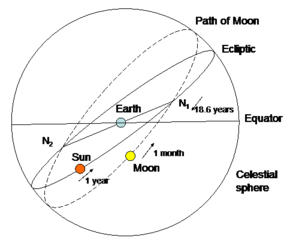 As seen by an observer on Earth on the imaginary celestial sphere, the Moon crosses the ecliptic every orbit at positions called nodes twice every month. When the full moon occurs in the same position at the node, a lunar eclipse can occur. These two nodes allow two to five eclipses per year, parted by approximately six months. (Note: Not drawn to scale. The Sun is much larger and farther away than the Moon.)
As seen by an observer on Earth on the imaginary celestial sphere, the Moon crosses the ecliptic every orbit at positions called nodes twice every month. When the full moon occurs in the same position at the node, a lunar eclipse can occur. These two nodes allow two to five eclipses per year, parted by approximately six months. (Note: Not drawn to scale. The Sun is much larger and farther away than the Moon.)
A partial lunar eclipse occurs when only a portion of the Moon enters the umbra. When the Moon travels completely into the Earth’s umbra, one observes a total lunar eclipse. The Moon’s speed through the shadow is about one kilometer per second (2,300 mph), and totality may last up to nearly 107 minutes. Nevertheless, the total time between the Moon’s first and last contact with the shadow is much longer, and could last up to 4 hours.[2] The relative distance of the Moon from the Earth at the time of an eclipse can affect the eclipse’s duration. In particular, when the Moon is near its apogee, the farthest point from the Earth in its orbit, its orbital speed is the slowest. The diameter of the umbra does not decrease appreciably within the changes in the orbital distance of the moon. Thus, a totally eclipsed Moon occurring near apogee will lengthen the duration of totality.
The timing of total lunar eclipses are determined by its contacts:[3]
- P1 (First contact): Beginning of the penumbral eclipse. The Earth's penumbra touches the Moon's outer limb.
- U1 (Second contact): Beginning of the partial eclipse. The Earth's umbra touches the Moon's outer limb.
- U2 (Third contact): Beginning of the total eclipse. The Moon's surface is entirely within the Earth's umbra.
- Greatest eclipse: The peak stage of the total eclipse. The Moon is at its closest to the center of the Earth's umbra.
- U3 (Fourth contact): End of the total eclipse. The Moon's outer limb exits the Earth's umbra.
- U4 (Fifth contact): End of the partial eclipse. The Earth's umbra leaves the Moon's surface.
- P2 (Sixth contact): End of the penumbral eclipse. The Earth's shadow no longer makes any contact with the Moon.
A selenelion or selenehelion occurs when both the Sun and the eclipsed Moon can be observed at the same time. This can only happen just before sunset or just after sunrise, and both bodies will appear just above the horizon at nearly opposite points in the sky. This arrangement has led to the phenomenon being referred to as a horizontal eclipse. It happens during every lunar eclipse at all those places on the Earth where it is sunrise or sunset at the time. Indeed, the reddened light that reaches the Moon comes from all the simultaneous sunrises and sunsets on the Earth. Although the Moon is in the Earth’s geometrical shadow, the Sun and the eclipsed Moon can appear in the sky at the same time because the refraction of light through the Earth’s atmosphere causes objects near the horizon to appear higher in the sky than their true geometric position.[4]
The Moon does not completely disappear as it passes through the umbra because of the refraction of sunlight by the Earth’s atmosphere into the shadow cone; if the Earth had no atmosphere, the Moon would be completely dark during an eclipse. The red coloring arises because sunlight reaching the Moon must pass through a long and dense layer of the Earth’s atmosphere, where it is scattered. Shorter wavelengths are more likely to be scattered by the air molecules and the small particles, and so by the time the light has passed through the atmosphere, the longer wavelengths dominate. This resulting light we perceive as red. This is the same effect that causes sunsets and sunrises to turn the sky a reddish color; an alternative way of considering the problem is to realize that, as viewed from the Moon, the Sun would appear to be setting (or rising) behind the Earth.
The amount of refracted light depends on the amount of dust or clouds in the atmosphere; this also controls how much light is scattered. In general, the dustier the atmosphere, the more that other wavelengths of light will be removed (compared to red light), leaving the resulting light a deeper red color. This causes the resulting coppery-red hue of the Moon to vary from one eclipse to the next. Volcanoes are notable for expelling large quantities of dust into the atmosphere, and a large eruption shortly before an eclipse can have a large effect on the resulting color.
Danjon scale
The following scale (the Danjon scale) was devised by André Danjon for rating the overall darkness of lunar eclipses:[5]
- L=0: Very dark eclipse. Moon almost invisible, especially at mid-totality.
- L=1: Dark eclipse, gray or brownish in coloration. Details distinguishable only with difficulty.
- L=2: Deep red or rust-colored eclipse. Very dark central shadow, while outer edge of umbra is relatively bright.
- L=3: Brick-red eclipse. Umbral shadow usually has a bright or yellow rim.
- L=4: Very bright copper-red or orange eclipse. Umbral shadow is bluish and has a very bright rim.
Eclipse cycles
See also: Saros (astronomy) and Eclipse cycleEvery year there are at least two lunar eclipses, although total lunar eclipses are significantly less common. If one knows the date and time of an eclipse, it is possible to predict the occurrence of other eclipses using an eclipse cycle like the saros.
Recent and forthcoming lunar eclipse events
- March 3, 2007, lunar eclipse ― The first total lunar eclipse of 2007 occurred on March 3, 2007, and was partially visible from the Americas, Asia and Australia. The complete event was visible throughout Africa and Europe. The event lasted seventy-five minutes, began at 20:16 UTC, and reached totality at 22:43 UTC.[6]
- August 2007 lunar eclipse ― August 28, 2007, saw the second total lunar eclipse of the year. The initial stage began at 07:52 UTC, and reached totality at 09:52 UTC. This eclipse was viewable form Eastern Asia, Australia and New Zealand the Pacific, and the Americas.[7]
- February 2008 lunar eclipse ― The only total lunar eclipse of 2008 occurred on February 21, 2008, beginning at 01:43 UTC, visible from Europe, the Americas, and Africa.[8]
- There was a partial eclipse of the Moon on December 31, 2009.
- There was a partial eclipse of the Moon on June 26, 2010.
- There was a total eclipse of the Moon on December 21, 2010.
- There was a total eclipse of the Moon on June 15, 2011.
- The next total eclipse of the Moon will occur on December 10, 2011.
Gallery
-
Painting by Lucien Rudaux, showing what a lunar eclipse might look like when viewed from the surface of the moon. The moon's surface appears red because the only sunlight available is refracted through the Earth's atmosphere on the edges of the earth, as shown in the sky in this painting.
See also
- Lunar eclipses in history
- Eclipse
- Moon illusion
- Orbit of the Moon
References
- ^ "Total Lunar Eclipse of December 21, 2010". Outer Space Universe. http://www.outerspaceuniverse.org/total-lunar-eclipse-of-december-21-2010.html. Retrieved 20 December 2010.
- ^ Hannu Karttunen. Fundamental Astronomy. Springer. http://books.google.com/books?id=DjeVdb0sLEAC&pg=PA139&lpg=PA139&dq=lunar+eclipse+%22maximum+duration%22.
- ^ Clarke, Kevin. "On the nature of eclipses". Inconstant Moon. Cyclopedia Selenica. http://www.inconstantmoon.com/cyc_ecl1.htm. Retrieved 19 December 2010.
- ^ John Hammond (May 15, 2003). "Weather Centre: Astronomical event threatened by the Great British weather". BBC News. http://www.bbc.co.uk/weather/ukweather/daily_review/news/15052003news.shtml. Retrieved 2008-02-20.
- ^ Paul Deans and Alan M. MacRobert. "Observing and Photographing Lunar Eclipses". Sky and Telescope. http://skytonight.com/observing/objects/eclipses/3304036.html.
- ^ "Total Lunar Eclipse: March 3, 2007". NASA Eclipse Page. NASA. 2008. http://sunearth.gsfc.nasa.gov/eclipse/OH/OH2007.html. Retrieved 2008-02-20.
- ^ "Total Lunar Eclipse: August 28, 2007". NASA Eclipse Page. NASA. 2008. http://sunearth.gsfc.nasa.gov/eclipse/LEmono/TLE2007Aug28/TLE2007Aug28.html. Retrieved 2008-02-20.
- ^ "Total Lunar Eclipse: February 20, 2008". NASA Eclipse Page. NASA. 2008. Archived from the original on 2008-02-18. http://web.archive.org/web/20080218025416/http://sunearth.gsfc.nasa.gov/eclipse/LEmono/TLE2008Feb21/TLE2008Feb21.html. Retrieved 2008-02-20.
- Bao-Lin Liu, Canon of Lunar Eclipses 1500 B.C.-A.D. 3000, 1992
- Jean Meeus and Hermann Mucke Canon of Lunar Eclipses. Astronomisches Büro, Vienna, 1983
- Espenak, F., Fifty Year Canon of Lunar Eclipses: 1986-2035. NASA Reference Publication 1216, 1989
External links
- A good video introduction to Lunar Eclipses from NASA
- Lunar Eclipse: how to photograph
- Live Free Lunar eclipse webcast & hands-on lunar eclipse experiments: 2011-06-15
- Live-webcast of the lunar eclipse on June 15th, 2011, University of Applied Sciences Offenburg/Germany
- Worldwide viewing times for the December 2010 Total Lunar Eclipse
- Animated explanation of the mechanics of a lunar eclipse, University of Glamorgan
- Lunar Eclipse time sequence
- U.S. Navy Lunar Eclipse Computer
- NASA Eclipse home page
- Search among the 12,064 lunar eclipses over five millennium and display interactive maps
- Lunar Eclipses for Beginners
- Eclipse Geeks
- Shadow and Substance for animation of future and past eclipses
- Tips on photographing the lunar eclipse from New York Institute of Photography
- Total Lunar Eclipse, December 2010 - slideshow by Life magazine
The Moon Physical features 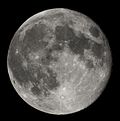
Orbit - Orbit of the Moon
- Phases
- Solar eclipse
- Lunar eclipse
- Tide
Lunar surface - Selenography
- Near side
- Far side
- Lunar mare
- (List)
- Craters
- (List)
- Mountains
- Valleys
- South Pole – Aitken basin
- Shackleton crater
- Water
- Soil
- Peak of eternal light
- Space weathering
- Transient lunar phenomenon
Lunar science Exploration Other topics - See also Solar System
- Natural satellite
Lunar eclipses Lists of
eclipsesAll: Central total eclipses · Total penumbral eclipses
By century: 20th BCE · 19th BCE · 18th BCE · 17th BCE · 16th BCE · 15th BCE · 14th BCE · 13th BCE · 12th BCE · 11th BCE · 10th BCE · 9th BCE · 8th BCE · 7th BCE · 6th BCE · 5th BCE · 4th BCE · 3rd BCE · 2nd BCE · 1st BCE · 1st · 2nd · 3rd · 4th · 5th · 6th · 7th · 8th · 9th · 10th · 11th · 12th · 13th · 14th · 15th · 16th · 17th · 18th · 19th · 20th · 21st · 22nd · 23rd · 24th · 25th · 26th · 27th · 28th · 29th · 30th
Saros cycles: 100 · 101 · 102 · 103 · 104 · 105 · 106 · 107 · 108 · 109 · 110 · 111 · 112 · 113 · 114 · 115 · 116 · 117 · 118 · 119 · 120 · 121 · 122 · 123 · 124 · 125 · 126 · 127 · 128 · 129 · 130 · 131 · 132 · 133 · 134 · 135 · 136 · 137 · 138 · 139 · 140 · 141 · 142 · 143 · 144 · 145 · 146 · 147 · 148 · 149 · 150 · 151 · 152 · 153 · 154 · 155 · 156 · 157 · 158 · 169 · 160 · 161 · 162 · 163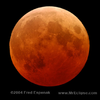
Total
eclipsesPast1910 May 24 · 1913 Sep 15 · 1920 May 03 · 1921 Apr 22 · 1928 Jun 3 · 1939 May 3 · 1946 Jun 14 · 1950 Apr 2 · 1953 Jan 29 · 1953 Jul 26 · 1954 Jan 19 · 1956 Nov 18 · 1957 May 13 · 1957 Nov 7 · 1960 Mar 13 · 1960 Sep 5 · 1963 Dec 30 · 1964 Jun 25 · 1964 Dec 19 · 1967 Apr 24 · 1967 Oct 18 · 1968 Apr 13 · 1968 Oct 6 · 1971 Feb 10 · 1971 Aug 6 · 1972 Jan 30 · 1974 Nov 29 · 1975 May 25 · 1975 Nov 18 · 1978 Mar 24 · 1978 Sep 16 · 1979 Sep 6 · 1982 Jan 9 · 1982 Jul 6 · 1982 Dec 30 · 1985 May 4 · 1985 Oct 28 · 1986 Apr 24 · 1986 Oct 17 · 1989 Feb 20 · 1989 Aug 17 · 1990 Feb 9 · 1992 Dec 9 · 1993 Jun 4 · 1993 Nov 29 · 1996 Apr 4 · 1996 Sep 27 · 1997 Sep 16 · 2000 Jan 21 · 2000 Jul 16 · 2001 Jan 9 · 2003 May 16 · 2003 Nov 9 · 2004 May 4 · 2004 Oct 28 · 2007 Mar 3 · 2007 Aug 28 · 2008 Feb 21 · 2010 Dec 21 · 2011 Jun 15
Future2011 Dec 10 · 2014 Apr 15 · 2014 Oct 8 · 2015 Apr 4 · 2015 Sep 28 · 2018 Jan 31 · 2018 Jul 27 · 2019 Jan 21 · 2021 May 26 · 2022 May 16 · 2022 Nov 8 · 2025 Mar 14 · 2025 Sep 7 · 2026 Mar 3 · 2028 Dec 31 · 2029 Jun 26 · 2029 Dec 20 · 2032 Apr 25 · 2032 Oct 18 · 2033 Apr 14 · 2033 Oct 8 · 2036 Feb 11 · 2036 Aug 7 · 2037 Jan 31 · 2040 May 26 · 2040 Nov 18 · 2043 Mar 25 · 2043 Sep 19 · 2044 Mar 13 · 2044 Sep 7 · 2047 Jan 12 · 2047 Jul 7 · 2048 Jan 1 · 2050 May 6 · 2050 Oct 30
Partial
eclipsesPast1903 Apr 12 · 1914 Mar 12 · 1932 Mar 22 · 1952 Feb 11 · 1952 Aug 5 · 1954 Jul 16 · 1955 Nov 29 · 1956 May 24 · 1958 May 3 · 1959 Mar 24 · 1961 Mar 2 · 1961 Aug 26 · 1963 Jul 6 · 1965 Jun 14 · 1970 Feb 21 · 1970 Aug 17 · 1972 Jul 26 · 1973 Dec 10 · 1974 Jun 4 · 1976 May 13 · 1977 Apr 4 · 1979 Mar 13 · 1981 Jul 17 · 1983 Jun 25 · 1988 Mar 3 · 1988 Aug 27 · 1990 Aug 6 · 1991 Dec 21 · 1992 Jun 15 · 1994 May 25 · 1995 Apr 15 · 1997 Mar 24 · 1999 Jul 28 · 2001 Jul 5 · 2005 Oct 17 · 2006 Sep 7 · 2008 Aug 16 · 2009 Dec 31 · 2010 Jun 26
Future2012 Jun 4 · 2013 Apr 25 · 2017 Aug 7 · 2019 Jul 16 · 2021 Nov 19 · 2023 Oct 28 · 2024 Sep 18 · 2026 Aug 28 · 2028 Jan 12 · 2028 Jul 6 · 2030 Jun 15 · 2034 Sep 28 · 2035 Aug 19 · 2037 Jul 27 · 2039 Jun 6 · 2039 Nov 30 · 2041 May 16 · 2041 Nov 8 · 2042 Sep 29 · 2046 Jan 22 · 2046 Jul 18 · 2048 Jun 26
Categories:- Astronomical events
- Eclipses
- Lunar eclipses
- Observing the Moon
Wikimedia Foundation. 2010.

